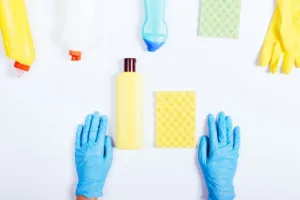As I wrote in my previous article, “Cleaning Things Up: Technical Hygiene in the Covidian Age”, many of us are now hyperaware (almost to the point of bacillophobia) of cleaning often-used equipment surfaces in the education sector. One educator summarizes the covid-cleaning predicament in schools and universities in this way:

“The problem with the virus is that it is invisible and so people tend to over-sanitize, taking up the mindset that the surfaces are [always] infected”.
In order to understand the depths of concern about this hygiene issue at the grassroots level in schools, let’s use some examples from a recent educational discussion forum now playing out in Ireland. Here are some of the key questions emerging, paraphrased here, but expressed by actual teachers:
- Is it enough for children to wash hands or disinfect hands before and after using the laptop or iPad?
- Is it okay to use sprays on digital equipment?
- How can we make this process less cumbersome?
- Must we turn devices off when cleaning them?
- How can we get a lab of devices ready for the next class?
- Are protective keyboard covers worth the investment?
- What vendors are you using for cleaning materials?
- Don’t we have any national disinfecting standards to follow?
You can tell by the last question that it’s a jungle out there, with classroom teachers/professors largely left on their own to solve this in any way they can. Some of their ‘hacked’ or well-intentioned hygiene solutions include:
“We’re spraying them with 70% isopropyl alcohol [not spraying in the classroom, however] and wiping quickly with lint-free microfiber. It evaporates quickly”.
“We work with a company in the North East of England who have partnered with a manufacturer of a water-based solution, which has a certificate confirming protection for 28 days on hard and soft surfaces. NICE CO is an education company and so has a particular interest in keeping young people safe. We tend to spray a microfibre cloth with the solution and then clean down the keyboards, screens and mouse. The website shows an animation of how the solution works to protect surfaces”.
One vendor noted:
“We have supplied over 10,000 Protective Keyboard Covers to the HSE to help prevent the spread of covid-19 within the health service and are supplying sectors within UCD, DCU and IADT for the same”.
Of course, we have also seen the rise of industrial-strength, institutional quality sanitizing equipment. In my previous article, I introduced the powerhouse Uvisan UV disinfecting/charging/security/storage cabinet for VR headgear, tablets, phones and similar shared resources. I should also mention a competing solution, Cleanbox. There is no doubt that the attention being paid to sanitizing shared equipment in the education market is only going to ratchet up. –Len Scrogan

